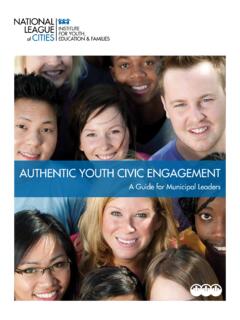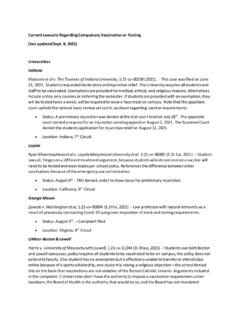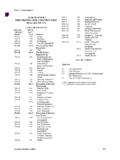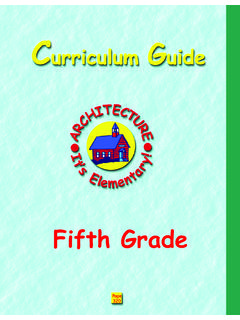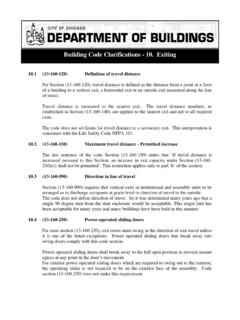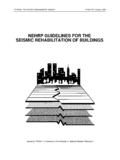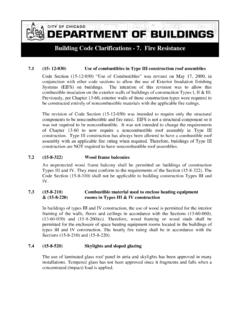Transcription of Trends in Smart City Development - Cities Strong …
1 Trends in < Strong >SmartStrong > CityDevelopmentNATIONALLEAGUEOF < Strong >CitiesStrong > 2016 National League of < Strong >CitiesStrong > . All Rights This PublicationResearch for this guide and the original draft of the document were completed by graduate students at the American University Department of Public Administration and Policy. Contributors include Reena Shrestha, Cynthia Castro, and Fletcher Smith. These students worked in partnership with Brooks Rainwater and Nicole DuPuis at the National League of < Strong >CitiesStrong > (NLC) to conduct an analysis of < Strong >SmartStrong > city implementation across the country and around the world. The final report was prepared by Nicole DuPuis and Elias Stahl at National League of < Strong >CitiesStrong > is the nation s oldest and largest organization devoted to strengthening and promoting < Strong >CitiesStrong > as centers of opportunity, leadership, and governance.
2 NLC is a resource and advocate for more than 1,600 member < Strong >CitiesStrong > and the 49 state municipal leagues, representing 19,000 < Strong >CitiesStrong > and towns and more than 218 million Americans. NLC s Center for city Solutions and Applied Research provides research and analysis on key topics and Trends important to < Strong >CitiesStrong > , creative solutions to improve the quality of life in communities, inspiration and ideas for local officials to use in tackling tough issues, and opportunities for city leaders to connect with peers, share experiences and learn about innovative approaches in you to Soren Messner Zidell, who created the data visualizations, cover illustration and report design, and to Paul Konz for editing the report. We are also grateful to all of the city officials, thought leaders, and experts who took the time to speak to us about < Strong >SmartStrong > < Strong >CitiesStrong > .
3 A very special thanks to our colleagues at the < Strong >SmartStrong > < Strong >CitiesStrong > Council, who lent their time and expertise as outside reviewers of this report: Sarah Blanchard, Stuart Cowan, and Liz Enbysk. Finally, thanks to Sonja Walti, Assistant Professor in the Department of Public Administration and Policy at American University, who facilitated this partnership. Trends in < Strong >SmartStrong > city DevelopmentCASE STUDIES AND RECOMMENDATIONSNATIONALLEAGUEOF CITIESE xecutive Summary10 IntroductionCase StudiesChicago, ILPhiladelphia, PACharlotte, NCSan Francisco, CANew Delhi, IndiaCase Study ComparisonRecommendationsAppendix1216172 2252730333439 Table of ContentsForewordCities are ever-changing; the dynamism of the urban environment is a microcosm of the societal interactions that we have built throughout history. Technology has always been a critical force deeply intertwined with the evolution of < Strong >CitiesStrong > .
4 From the first human settlements millennia ago to the industrial revolution to today, technological breakthroughs have impacted the buildings we use, the way we get around, and how we live, work, and play in the urban space. Now, as we are on the cusp of further rapid shifts in < Strong >CitiesStrong > precipitated by technology, it is worth imagining what the connected < Strong >SmartStrong > city of the future will look like and the associated impact it will have on our everyday lives. Take a typical day in the life of a community member in this hypothetical future who wakes up in their connected house with artificial intelligence automating everything from temperature preference to light levels to health monitoring and more and scale it to the city at large. < Strong >CitiesStrong > are beginning to, and will continue to, integrate technological dynamism into municipal operations, from transportation to infrastructure repair and more.
5 The back ends of these systems are not always apparent to the end user but as the integration of < Strong >SmartStrong > < Strong >CitiesStrong > technologies becomes more visible in our everyday lives, we could begin to see large scale changes in our < Strong >CitiesStrong > . Autonomous vehicles on our roadways and the data that they provide could create environments where traffic lights become obsolete, traffic itself becomes a thing of the past, and < Strong >CitiesStrong > can once again be for people rather than cars, as different modes of transportation work in tandem and communicate with each another. Wi-Fi hotspots at scale like we are already starting to see in New York with LinkNYC could help transform the way we access information and help alleviate the digital divide. Thinking even further out, we can imagine that security protocols like facial recognition technology could help transform building security in < Strong >CitiesStrong > , making entrances and building design more fluid as we move away from the need to usher people through front doors.
6 Similarly, as we move toward greater usage of shared vehicles, we can move away from parking either below buildings or on streets, enabling < Strong >CitiesStrong > to recapture land for people and allowing developers to reduce the costs of buildings since parking garages will become an unnecessary sources could be completely renewable in the < Strong >SmartStrong > city of the future as well, with technology paving the way Brooks Rainwater Senior Executive and Director Center for city Solutions National League of Citiesfor better integration into our < Strong >CitiesStrong > and thereby helping to create a cleaner environment for everyone. At the same time, the < Strong >SmartStrong > city of the future can be safer with streetlight networks that use embedded sensors to detect gunshots or flash their lights during emergencies and the further integration of these systems will allow < Strong >CitiesStrong > to collect information from sources such as < Strong >SmartStrong > water, electric, and gas of this is predicated on the premise that technologies can help make people s lives better in < Strong >CitiesStrong > .
7 At the end of the day, technological developments will enhance our urban experience but they also risk leaving more people behind. To this end, we must be deliberate in the < Strong >DevelopmentStrong > of < Strong >SmartStrong > < Strong >CitiesStrong > and imbue equity as a primary goal so that the city of the future is a city for everyone. < Strong >CitiesStrong > are focused on these goals right now, and they are beginning to think about how these systems can be integrated to create feedback loops that improve operations and enhance the experience of community members. Fully connected < Strong >SmartStrong > < Strong >CitiesStrong > are coming, and we want to help < Strong >CitiesStrong > prepare for their arrival and provide local leaders with best practices in this arena. The National League of < Strong >CitiesStrong > (NLC) is pleased to share with you Trends in < Strong >SmartStrong > city < Strong >DevelopmentStrong > , which presents case studies and discusses how < Strong >SmartStrong > < Strong >CitiesStrong > are growing nationwide and globally.
8 It is our hope that this report will spark conversation and action among city leaders about how to incorporate these strategies into their own communities. NLC s Center for city Solutions and Applied Research strives to strengthen communities, transform and improve < Strong >CitiesStrong > , and assist city leaders. We do this by knowing and learning about < Strong >CitiesStrong > , identifying and sharing promising city practices, fostering effective solutions and innovation, and challenging city leaders to lead. We wish to thank the < Strong >CitiesStrong > who participated in this study. Created with our partners at the American University Department of Public Administration and Policy, this guidebook is meant to be a resource for < Strong >CitiesStrong > as they lead the way forward in this exciting and ever-evolving space. < Strong >SmartStrong > transportation systems use sensors to detect congestion and bottlenecks in traffic patterns.
9 They also rely on cameras to enforce speed and traffic infractions. In doing so, these tools gather real time information that can be used by city DOTs to make mobility networks safer and more devices can detect leaks as well as changes in water pressure to determine whether water infrastructure is working properly. Apps coordinate with < Strong >SmartStrong > parking meters to inform drivers of where there is parking availability. Sensors monitor the structural soundness of bridges and inform city engineers of any issues. Drones are used to inspect hard to reach cars shuttle people in and out of the city , providing rides for others and making deliveries while their owners are occupied with work or other detect the amount of garbage in recepticals around the city so that sanitation workers can maximize efficiency in their lights are weather adaptive and communications are automatically sent to the Department of Public Works when the bulbs need to be changed.
10 Public transit and city fleet vehicles communicate with their home agency when it is time for maintenance or replacement. Sensors monitor conditions in public parks and wooded areas that might be prone to fire. Sensors can also detect fires in buildings and initiate a call to the fire department in an plants can be monitored for safety and city officials can be informed of any influx in radiation safety officers can wear body cameras that capture footage of interactions between themselves and city residents to ensure safety for both ensure security by monitoring activity in areas that are not frequented by public safety officers. Areas that are not open to public access can be monitored to keep unauthorized personnel out. A reliable internet ecosystem is the glue that holds the internet of things together.



